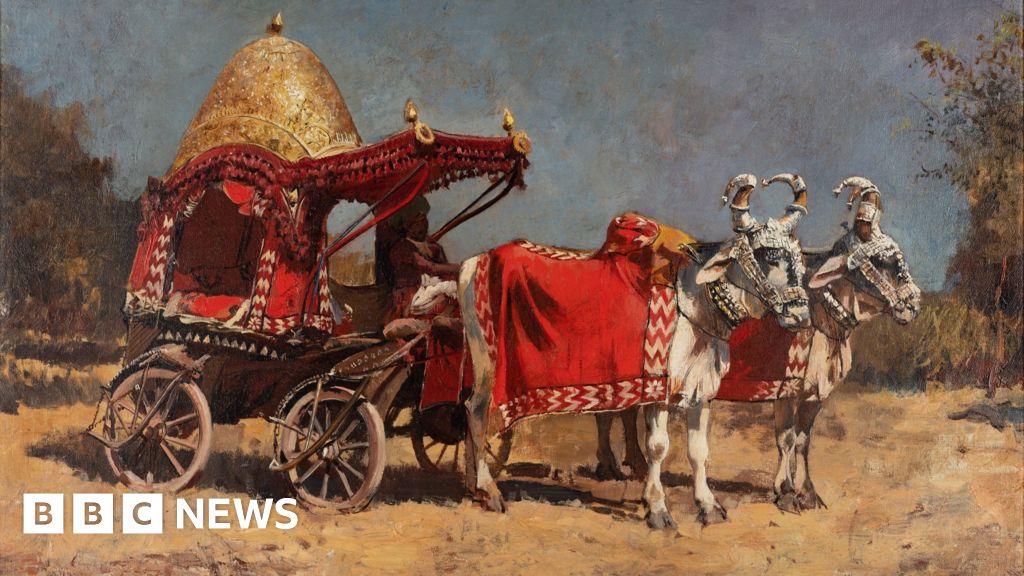From Sudha G Tilak, Delhi
 DGAP
DGAPA new exhibition in Delhi featuring rare works of art by European artists provides insights into British rule over the country.
The exhibition is entitled “Destination India: Foreign Artists in India, 1857–1947” and focuses on artists who traveled from all over the world to colonial India.
The depiction of India by European and British artists has “long been a subject of fascination and exploration,” writes Indian MP and author Shashi Tharoor in an introduction to the exhibition.
“The fascination with India’s unique landscapes, magnificent monuments, vibrant traditions and rich history has attracted many people who want to capture the essence of this multifaceted nation.”
Mr Tharoor notes that the show is “refreshing and important” because it focuses on the less explored but nonetheless compelling period of the late 19th and early 20th centuries, and not just the early pioneers.
The exhibition features works of art, including those by the British artist William Carpenter, which provide insights not only into the royal courts but also into daily life in the Empire.
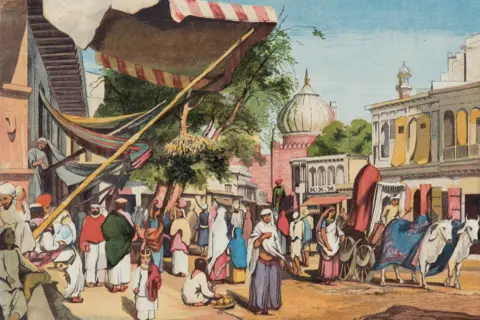 DGAP
DGAPCarpenter usually painted watercolors, but this 1857 artwork pictured above is a wood engraving on paper depicting the busy side streets of the Jama Masjid (mosque) in Delhi.
In the late 19th and early 20th centuries, many interesting artists from England and other European countries visited India. They were mainly conventional artists who worked in oil and watercolour painting and various printmaking techniques.
“They were attracted to people, not just the grandees but also the common people on the street. If there was an element of the picturesque left, it was a more intimate and vibrant version of that aesthetic,” says Ashish Anand, managing director of DAG, a leading arts company that put together the exhibition.
“In her works we find an India – if one can put it that way – that we can not only see, but also hear and smell.”
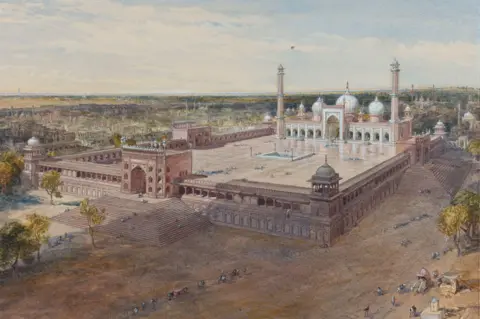 DGAP
DGAPThe above work is another watercolor painting of the Jama Masjid by William Simpson from 1864.
Simpson worked primarily as a war artist and was sent to India by a publisher in 1859 to illustrate the aftermath of the violent uprising two years earlier. Indian soldiers, known as sepoys, had instigated an uprising against British rule in 1857, often referred to as the First War of Independence.
Simpson's project was interrupted when the publisher went bankrupt. He called it the “greatest disaster of my life”. Nevertheless, he continued to travel and sketch his expeditions through the subcontinent.
 DGAP
DGAPThis is a pastel portrait of elderly Indians from 1900 by the Italian artist Olinto Ghilardi.
Ghilardi, an important European artist, influenced modern Indian art in the early 20th century.
He was Abanindranath Tagore, the nephew of Nobel Prize winner Rabindranath Tagore and founder of the Bengal School of Art, which shaped modern Indian painting. Ghilardi encouraged him to experiment with watercolors, gouache and pastels, which he later used extensively in his work.
Ghilardi was also deputy director of the Government School of Art in Calcutta (now Kolkata).
 DGAP
DGAPThis painting of a young Indian woman from 1896 is also by Ghilardi.
Not much is known about the Italian painter's life before his arrival in Calcutta. His association with Tagore shows that he was recognized as an artist among the Bengali elite of Calcutta.
Much later, in 1911, Ghilardi became a prominent member of an avant-garde group of Italian artists.
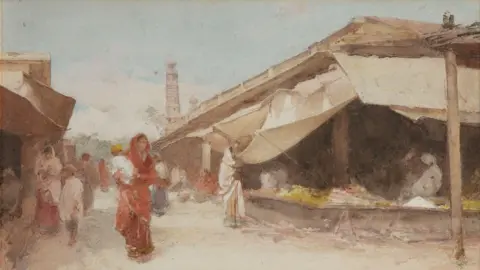 DGAP
DGAPThis is an undated watercolor painting of a street scene in India by British artist Carlton Alfred Smith.
Smith lived in India between 1916 and 1923. He often painted landscapes and portraits of people.
A late-Victorian painter from Camden Town, London, Smith began as a lithographer before switching to painting. A member of the Royal Academy of Art, he is known for his drawings of cottage interiors and the English countryside.
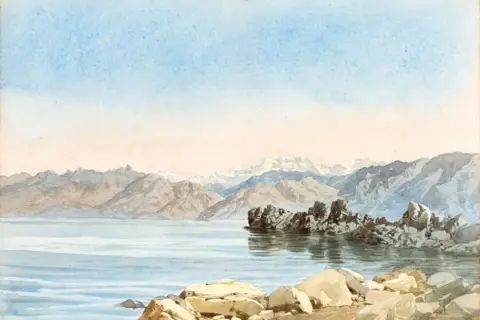 DGAP
DGAPThis is a watercolor painting of Wular Lake in Kashmir from 1894 by George Strahan, a British army engineer and artist.
Strahan, a bright student from Surrey, joined the army and came to India in 1860, where he worked in the cities of Roorkee and Haridwar.
Two years later, he joined the Topographical Survey of India and began mapping central India, Rajasthan and the Himalayas.
In 1888 he became director of the Great Trigonometrical Survey, which mapped the Indian subcontinent.
While surveying, Strahan drew relief maps before color printing was introduced.
After his retirement, he lived in the hills of Dehradun and traveled to Kashmir every summer.
 DGAP
DGAPThis is a watercolor painting of Hyderabad in South India from 1887 by the German artist Woldemar Friedrich.
Friedrich was a history painter and illustrator and taught at prestigious German art academies for much of his career. In the late 1880s he travelled to India and created a series of landscapes and illustrations that were published in the book Six Months in India in 1893.
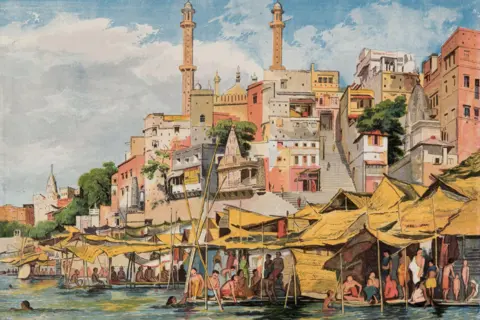 DGAP
DGAPCarpenter's 1857 wood-on-paper engraving of Benaras (above) shows Varanasi – one of the oldest cities in the world and India's spiritual capital – full of life.
Carpenter was educated at the Royal Academy Schools in London and became a famous portrait and landscape painter in the 19th century.
After arriving in India in 1850, he traveled extensively and painted rulers, street scenes, landscapes and natives in Bombay (now Mumbai), Rajasthan, Delhi, Punjab, Kashmir, Lahore, Ceylon (Sri Lanka) and Afghanistan.
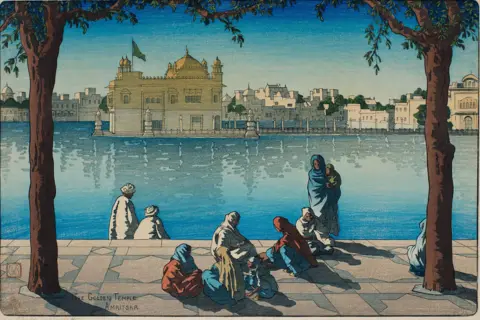 DGAP
DGAPThis is a woodcut reproduction of the Golden Temple in Punjab, a holy site of the Sikhs, by the English artist Charles William Bartlett from 1919 on paper.
Born in Dover, Bartlett was one of the world's leading Japanese woodblock artists and later turned to fine art.
In 1913 he travelled to India, Indonesia and China. From 1916 to 1925 he designed 38 woodcuts for his Japanese publisher, including many scenes from his travels through South Asia.
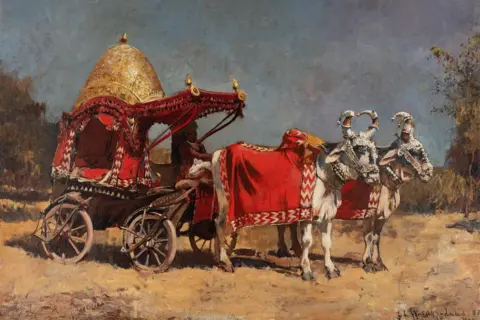 DGAP
DGAPAmerican artist Edwin Lord Weeks painted this colorful oil on canvas of a bullock cart in Ahmedabad, Gujarat in 1882.
Born in Boston to a wealthy family, Weeks was one of the first American artists to visit India. His business family supported his artistic endeavors.
Weeks first travelled to India between 1882 and 1883, painting mainly locations in Rajasthan. He returned in 1886 and visited at least seven cities. Known for his realistic style and attention to detail, Weeks also wrote a travelogue in 1896 about his travels through Persia (now Iran) and India.

“Incurable gamer. Infuriatingly humble coffee specialist. Professional music advocate.”

